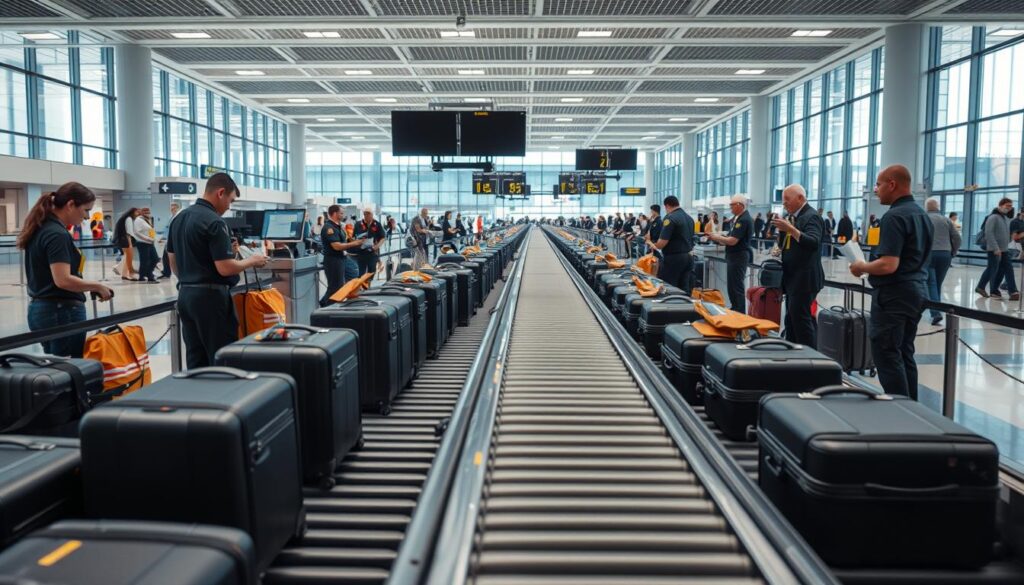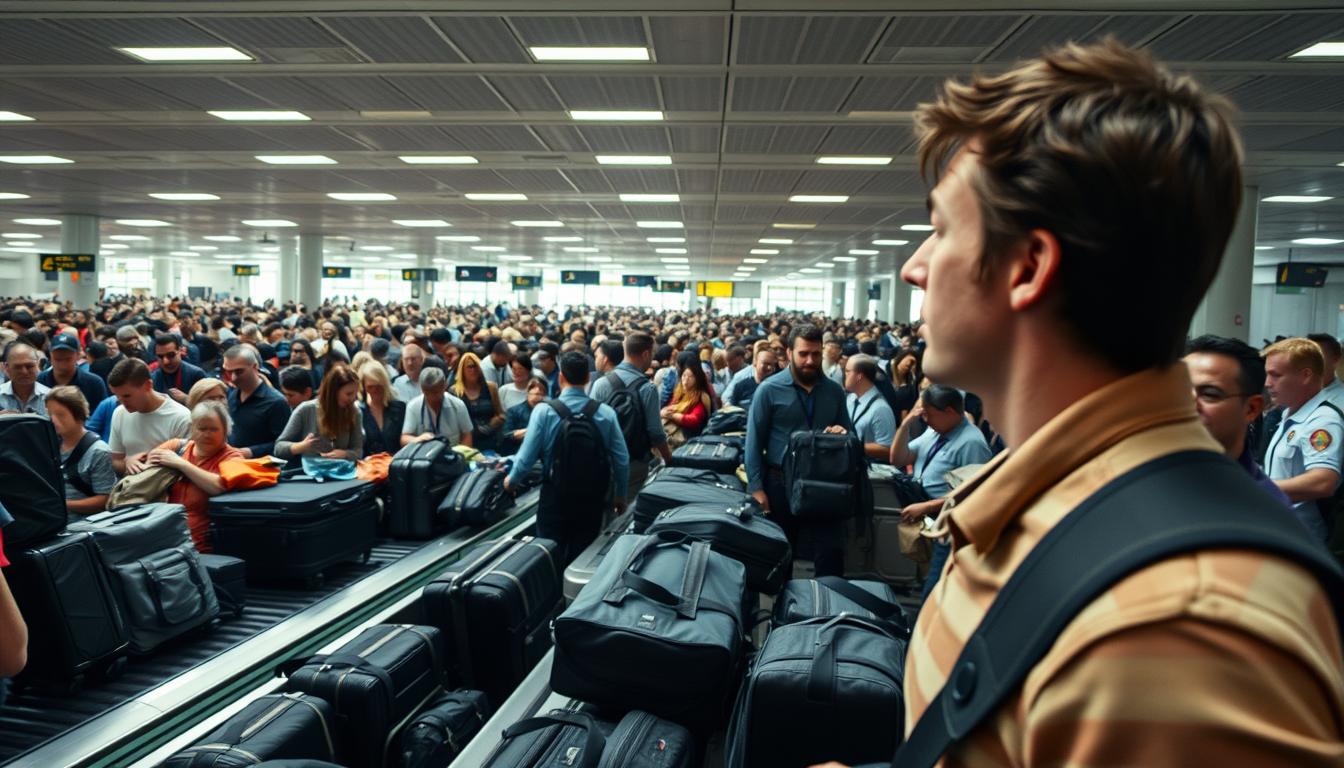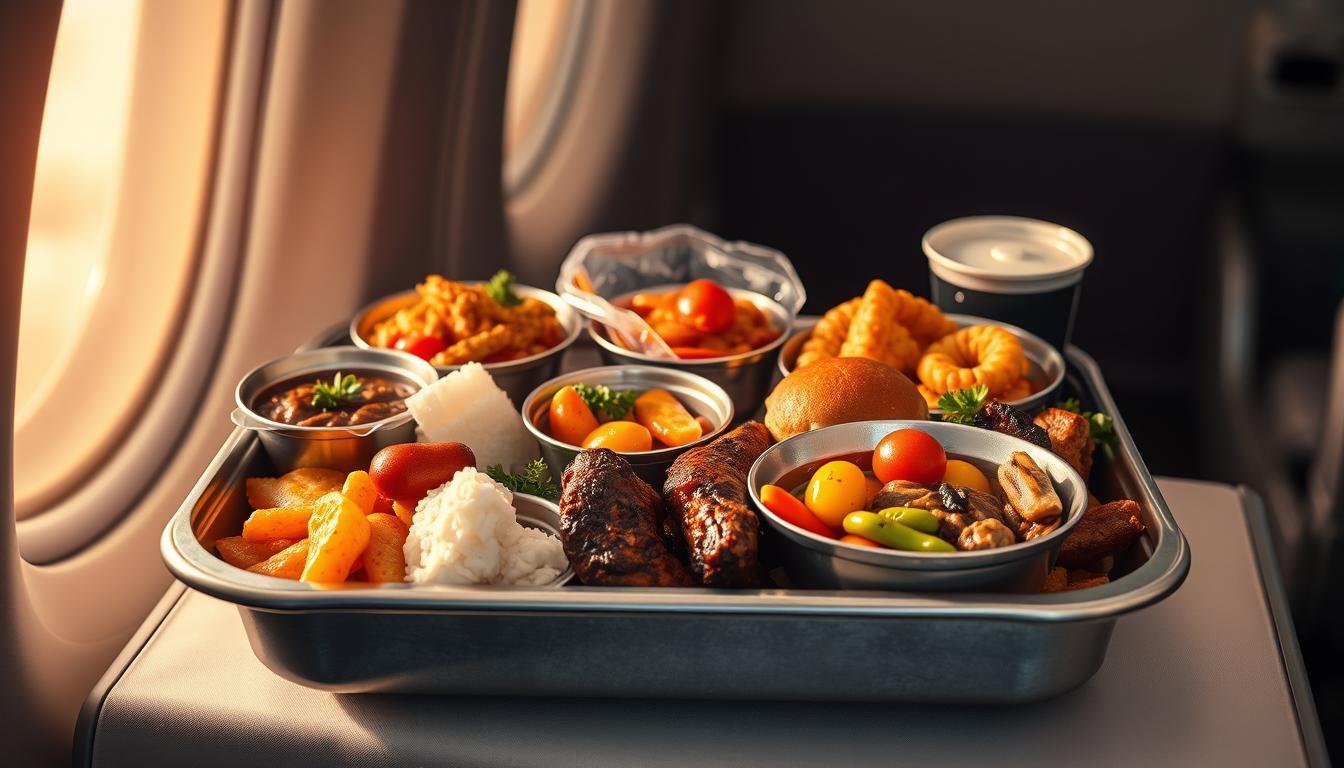Anúncios
Have you ever wondered what happens to baggage lost on the flight? It’s a very common concern among passengers, and understanding the process can help ease your anxiety.
When a bag is lost, airlines initiate a tracking process to locate it. But what happens behind the scenes?
Anúncios
Today, we’ll explore the first steps of baggage lost on the flight process and how passengers can be helped.
The airline baggage tracking process

Airlines use advanced technologies to track baggage and minimize mishandling, ensuring bags arrive at the correct destination.
How airlines identify bags
Luggage is identified using barcode labels and RFID technology, allowing for precise tracking of luggage location.
Anúncios
Labels and barcodes
Barcode labels are the most traditional form of identification, containing information about the passenger and the flight.
RFID Technology
RFID (Radio Frequency Identification) technology is more advanced and allows tags to be read without the need for visual contact, making the process more efficient.
Tracking systems used in Brazil
In Brazil, airports use different tracking systems, which can differ significantly between national airports.
Differences between national airports
Some Brazilian airports have adopted more advanced technologies, such as RFID, while others still rely on older systems, which can affect tracking efficiency.
It’s important for passengers to be aware of these differences and check the tracking policies of their airlines.
What happens to lost luggage on a flight?
The process of locating lost luggage begins with sending the bags to temporary storage centers. These centers are responsible for holding the bags until they are identified and returned to their owners.
Temporary storage centers
Temporary storage centers are places where lost luggage is stored, equipped with tracking and identification systems to help locate the bag’s owners.
Baggage is stored securely until it is identified and released to passengers.
Identification and classification process
Lost baggage is identified and classified using tracking systems. Bags are examined, and their contents are checked to find the owners’ contact information.
This process is crucial for reuniting bags with their owners as quickly as possible.
Average recovery time
The average recovery time for lost luggage may vary depending on whether the flight was domestic or international.
Domestic flights
For domestic flights, recovery times are generally faster due to the less complex tracking processes. On average, lost baggage on domestic flights is recovered within a few days.
International flights
For international flights, the process can take longer due to differences in tracking procedures and sometimes customs issues. Turnaround times can vary from one week to an additional week.
It’s important for passengers to stay in touch with their airlines for updated information on the whereabouts of their baggage.
Passenger rights in case of loss

In the event of lost luggage, it’s important for passengers to know their rights and seek effective solutions. Brazilian law offers support to passengers facing this situation.
Brazilian legislation on baggage
Brazilian legislation, including ANAC Resolution No. 400, establishes clear guidelines for airlines in cases of lost baggage, defining passenger rights and airline responsibilities.
ANAC Resolution No. 400
ANAC Resolution No. 400 is an important milestone in protecting passenger rights, determining that airlines must have clear procedures for handling lost baggage.
Legal deadlines for localization
The deadlines for locating lost baggage are defined by law. Airlines have a specific timeframe to locate and return baggage to passengers.
Liability of airlines
Airlines are responsible for compensating passengers in the event of lost baggage, as established by law, and it is essential that passengers understand these rights in order to assert their claims.
| Term | Action |
|---|---|
| Up to 21 days | Luggage location and return |
| After 21 days | Passenger compensation |
Knowing airline rights and responsibilities is important for passengers facing lost baggage, helping to ensure passengers receive proper treatment and due compensation.
How to report lost luggage on a flight
Losing luggage during a flight can be truly stressful, but knowing how to report the incident is essential. When your luggage is lost, it’s crucial to act quickly to increase your chances of recovering it.
Immediate procedures at the airport
When you realize your luggage is lost, the first step is to go to the airline’s service desk at the airport.
Service counter
At the counter, you must inform the attendant about the loss of your luggage and provide details about your bag, such as its description and identification tag.
PIR (Property Irregularity Report) Form
Next, you’ll need to fill out the PIR form, a standard document used by airlines to report irregular baggage. Be sure to provide accurate and detailed information.
Required documentation
To report your lost luggage, you will need to present documents such as your ticket, proof of baggage delivery and identification documents.
Process monitoring
After reporting your baggage, it’s important to track the tracking process. Airlines usually provide a tracking number for this purpose.
Tips to avoid lost luggage
To minimize the risk of lost baggage, it’s important that passengers take certain precautions. Even though airlines do everything possible to prevent losses, passenger cooperation is crucial.
Proper identification of bags
One of the key measures to prevent lost luggage is to properly label your luggage. Therefore, use visible identification tags and consider adding an internal tag with your contact information.
Use of technology for tracking
Technology can be a great help in preventing lost luggage. Smart tags and tracking apps allow you to track your luggage’s whereabouts in real time.
- Smart tags: Smart tags are devices that can be attached to your luggage, allowing tracking via GPS or Bluetooth.
- Monitoring applications: There are several apps that help you track your luggage, providing updates on its status.
What not to put in checked baggage
Avoid packing valuables or important documents in checked baggage, not only reducing the risk of losing valuable items but also making them easier to recover in the event of loss.
- Valuable items: Items such as jewelry, high-value electronics, and cash should be kept in your carry-on bag.
- Important documents: Documents such as passports, identity cards, and copies of important documents should be kept in a safe and accessible place.
The final destination of unclaimed bags
When luggage is lost and unclaimed, it has several possible destinations. In Brazil, airlines have specific procedures for handling this type of luggage.
Unclaimed baggage auctions in Brazil
One of the destinations for unclaimed baggage is auctions. These events are held by airlines or airports and offer participants the chance to purchase unclaimed baggage items.
How to participate
To participate in an unclaimed baggage auction, you usually need to register in advance. Interested parties should check the auction notices published by airlines or airports for dates, locations, and conditions of participation.
Regulation
These auctions are regulated in accordance with the rules of ANAC (National Civil Aviation Agency) and other competent authorities, and it is important that participants are aware of the rules and procedures.
Donations and disposal
In addition to auctions, unclaimed luggage can also be donated or discarded. Items in good condition can be donated to charity, while those that are damaged or worthless are disposed of in accordance with environmental regulations.
Conclusion

Baggage lost on the flight can be a truly stressful experience, but understanding the processes and rights can help minimize the impact.
It’s crucial that passengers are aware of their rights and know how to report lost baggage. Furthermore, following simple tips, such as properly labeling bags and using tracking technology, can significantly reduce the risk of loss.
By understanding airline procedures and compensation limits, passengers can more effectively deal with lost baggage.




